
Under The Radar
About
We speak with businesses, industry leaders, venture capitalists and startups on their assessment of the business environment they're in, and what the future holds for them.
JUL 3, 2024
03/07/24 - Under the Radar: Sony Music Entertainment on ASEAN pop culture, Singapore as a live music hub, relationship between record labels and streaming, social media platforms, stance on AI
Pop diva Celine Dion, American country music singer Nate Smith, and Korean girl group Blackpink’s Lisa. They have all worked with the company we’re going to talk to for today, in one capacity or another.
With a footprint spanning across 100 countries, our guest Sony Music Entertainment, an American music recording company owned by the Sony Music Group.
The company prides itself as sitting at the intersection of music, entertainment and technology, bringing imagination and expertise to the newest products, platforms, embracing new business models and breakthrough tools as it helps artists push through creative boundaries and reach new audiences.
It supports a diverse roster of international superstars, developing and independent artists and visionary creators, and is said to be one of the big three recording labels in the world as of last year.
According to data from Statista, Sony Corporation's music segment revenue for 2023 stood at a whopping US$10.35 billion, up from the US$9.15 billion seen in FY2022.
But to what extent is this driven by Sony Music Entertainment, and how far have markets in Southeast Asia, and in particular Singapore, Malaysia and Vietnam contributed to the numbers?
Which are the key trends to watch in the music industry and which will be the key markets that will lead the pop culture in ASEAN? How will changing patterns in music consumption augment the power dynamics between record companies and streaming players, and increasingly, social media platforms?
And what value does Singapore bring to record labels with the country being the hotspot for live music events with global acts by international names such as Tate Mcrae and Laufey?
Plus – what is Sony Music Entertainment's stance towards the use of artificial intelligence in music creation?
On Under the Radar, The Evening Runway’s finance presenter Chua Tian Tian posed these questions to Kenny Ong, Managing Director for Malaysia, Vietnam and Singapore and Special Projects Southeast Asia, Sony Music Entertainment.
|
|
|
|
41:48
|
JUN 27, 2024
27/06/24 - Under the Radar: Geneco spills the beans on the secret recipe to remain competitive in Singapore’s Open Electricity Market, whether wholesale prices are stabilising, and what the green wave means for energy retailers
Retailing is the action of selling goods and services to consumers piecemeal rather than to businesses in bulk.
When we think of retailers, we often think of the likes of clothing retailers and electronic retailers. But instead of selling consumer goods, our guest for today sells the electricity we use to power our homes and electronics.
Established back in 2001 under its former name Seraya Energy, our guest for today is Geneco, a subsidiary of YTL PowerSeraya, one of Singapore’s first and largest electricity generators, with a licensed generating capacity of 3,100MW.
The firm used to serve just commercial and industrial customers back in the days until further liberalisation of the Singapore electricity market kicked in in 2018.
It was then that the company re-established itself as Geneco and expanded its scope to also cater to households and small and medium sized enterprises. Since then, the firm’s retail business grew further over the years, powering over 165,000 households in the lion city as of 2024.
But why are we talking to Geneco you might ask? Well, the Singapore electricity retail market is an interesting one to look at. It used to be rather vibrant back in 2018, with customers able to choose their electricity provider from a list of over 20 retailers.
Just a number of years later, a number of players including Singapore’s largest independent electricity retailer iSwitch left the industry due to cut throat competition, volatility in wholesale electricity prices, not to mention the energy crisis fuelled by the Russia-Ukraine war.
So what was the secret sauce that allowed Geneco to continue growing, on top of remaining in business?
Speaking of energy crisis, Geneco had said in April 2023 that electricity bill that year could be cheaper as global energy prices stabilise, but how far has that played out, and what is the situation like right now with demand for electricity expected to grow as the economy revs back to life from the pandemic? And what will that mean for Geneco ultimately when it filters through to its top and bottom lines?
On Under the Radar, The Evening Runway’s finance presenter Chua Tian Tian posed these questions to Lim Han Kwang, CEO, Geneco, Group Head (Retail, Regulation and Renewables) YTL PowerSeraya Ltd.
|
|
|
|
30:18
|
JUN 25, 2024
25/06/24 - Under the Radar: Why are Turkey, Kazakhstan bright spots for brokerage firm Phillip Nova? Its CEO tells it all.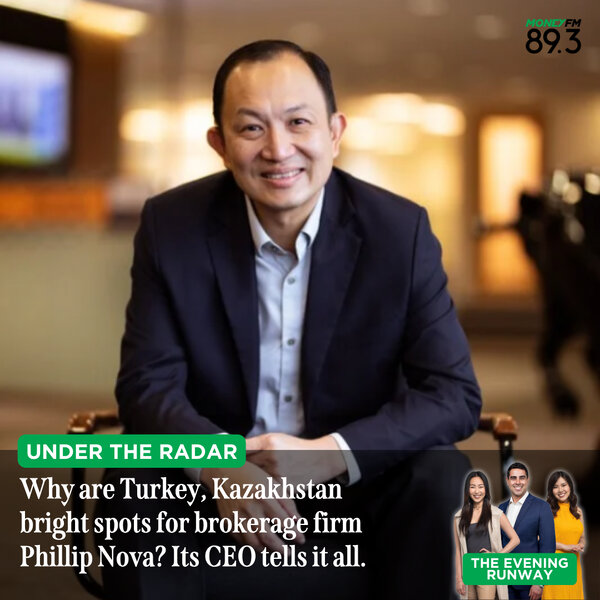
The securities market is in focus today as we speak to one of the founding clearing members of the Singapore Exchange Derivatives Trading or (SGX-DT).
Inaugurated some 40 years ago in 1983 as Phillip Futures, our guest for today is multi-asset broker Phillip Nova.
As a member of the PhillipCapital Group, the company has grown over the years and now prides itself as one of the region’s top brokers for the trading of CFD, Forex, Futures and Stocks.
It also taps PhillipCapital Group’s network companies to access exchanges around the world, including the Singapore Exchange, the Hong Kong Exchange, the Japanese Exchange Group, the New York Mercantile Exchange, the COMEX and more.
The company was rebranded in Phillip Nova in 2022 after the firm received its own securities brokerage licence to broaden its service offerings.
Its CEO had said then that the rebranding initiative was meant to reflect the brokerage’s expanded suite of offerings ranging across five asset classes namely: stocks, futures, forex, commodities and CFDs.
But Phillip Nova is an interesting company to talk about not just because of the rebranding initiative, but also because of the markets it is eyeing on in a bid to drive growth.
For one thing, the firm had in March this year offered the trading of Istanbul-quoted futures.
Representatives of its parent company, PhillipCapital had also met up with the senior management team of the regulator of financial services in the Republic of Kazakhstan, on the sidelines of the Kazakhstan-Singapore Business Forum that took place in May last year.
But what are the opportunities in these markets, and how will Phillip Nova partner up with industry players to deepen its stock trading links in order to penetrate into these relatively untapped markets?
On Under the Radar, The Evening Runway’s finance presenter Chua Tian Tian posed these questions to Teyu Che Chern, CEO, Phillip Nova.
|
|
|
|
36:58
|
JUN 21, 2024
21/06/24 - Under the Radar: Why did OUE REIT rebrand itself from OUE Commercial REIT and how far will growth be driven by its hospitality and retail properties looking forward?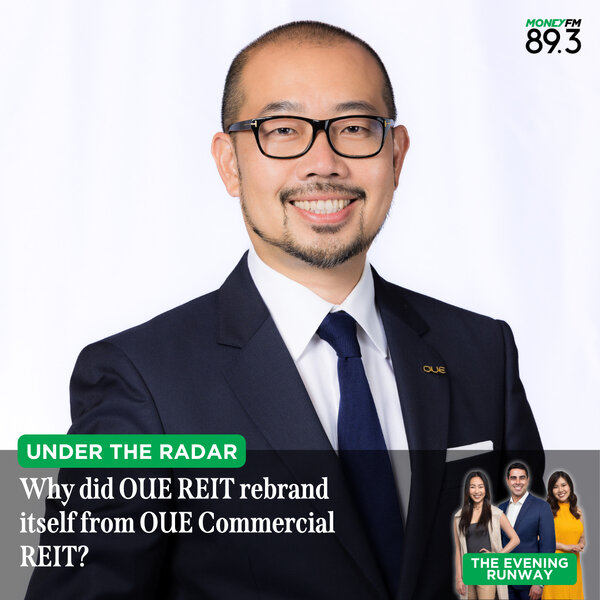
It’s all about S-Reits today as we continue our conversation with a company that is also the first ever guest we had on board on Under the Radar back in February last year.
Make a guess! The company is behind some of the most prominent skyscrapers we see at the Central Business District, and is said to be one of the largest diversified S-Reits with total assets under management of S$6.3 billion as at the end of 2023.
Well, listed on the mainboard of the Singapore Exchange back in January 2014, OUE REIT is a wholly owned subsidiary of OUE Limited, a leading real estate and healthcare group that looks to tap growth trends across Asia.
On its own, OUE REIT owns two hotels, namely Hilton Singapore and Crowne Plaza Changi Airport. It also counts the Mandarin Gallery, as well as commercial properties OUE Bayfront, One Raffles Place and OUE Downtown Office as its assets. Out of Singapore, the Reit also owns a Grade A commercial asset called Lippo Plaza in Shanghai’s business district of Puxi.
But why are we talking to OUE REIT you might ask? Well, OUE REIT was recently rebranded from OUE Commercial REIT in January 2024 to reflect its focus on growth opportunities in the hospitality, office and retail sectors, but what can we look forward to on this front?
Meanwhile, OUE REIT had also in April reported higher revenue and net property income in the first quarter of 2024, where net property income rose 6.9 per cent on the year to S$60.5 million. But how far is this driven by commercial properties and increased tourist spending at its hotels and how far can this continue?
On Under the Radar, The Evening Runway’s finance presenter Chua Tian Tian posed these questions to Han Khim Siew, Chief Executive Officer and Executive Director of OUE REIT.
|
|
|
|
31:13
|
JUN 19, 2024
19/06/24 - Under the Radar: Patek Philippe on Watches and Wonders, the importance of retaining creative control of the firm, and what growing Swiss watch exports means for it
When it comes to watch manufacturers, one would realise that most of the big players are owned by luxury groups with multiple brands under their belts. But instead of that, our guest for today prides itself as the last family-owned independent Genevan Watch Manufacturer.
It is also part of the so-called “The Holy Trinity” or “The Big Three” in horology - a term that describes three of the biggest and oldest watchmakers in the world.
Founded in 1839, our guest Patek Philippe has been perpetuating the tradition of Genevan watchmaking without interruption for close to two centuries.
As a family-owned independent watch manufacturer, the firm enjoys total creative freedom to entirely design, produce and assemble what experts agree to be the finest timepieces in the world, amassing a repertoire of over 80 patents so far.
Being an independent and private company also means Patek Philippe was able to make certain decisions that were unimaginable at other companies, such as retiring one of its most popular models, the Ref. 5711 Nautilus watch.
But what was the rationale behind the move? And with Patek Philippe launching a total of 11 watches at the highly anticipated Watches and Wonders this year, what is next for the firm as it continues to reinvent the wheel?
On the demand side of things, a Robb Report article citing Watch Pro reported in May that Swiss watch exports grew 4.5 per cent globally, bolstered by a 11.6 per cent rise in the US. The showing was a reversal from the decline seen in March, where shipments to China and Hong Kong fell.
But what does that mean to Patek Philippe operationally and how long is the waitlist for a first-hand timepiece?
On Under the Radar, The Evening Runway’s finance presenter Chua Tian Tian posed these questions to Deepa Chatrath, General Manager, Patek Philippe Southeast Asia.
|
|
|
|
42:54
|
JUN 14, 2024
14/06/24 - Under the Radar: Singlife’s Group CEO on the firm’s move to provide comprehensive insurance for dementia, preventative care amid ageing population
It’s all about insurance coverage today as we speak to a company that provides coverage for Singaporeans including the nation’s protectors – the MINDEF.
Formed by the merger of Aviva Singapore and Singlife in a deal valued at S$3.2 billion in 2020, the current Singlife is one of the largest homegrown financial services companies in the lion city.
The company offers a variety of insurance products ranging from life insurance, medical insurance, car insurance, travel insurance, home insurance, to investment linked-plans.
It is also seeing a number of key developments of late. For one thing, the company has become a fully owned subsidiary of Japan’s Sumitomo Life in a transaction valuing Singlife at S$4.6 billion.
The insurer said the ownership change will not affect its day-to-day operations, but will enable Singlife to pursue its long-term growth ambitions, with the capital to drive regional expansion and to grow as an integrated financial services company.
But what can we expect when it comes to Singlife’s strategic direction for the future?
Speaking of strategic direction, Singlife had in May this year launched what it calls the Singlife Dementia Cover. Touted as the market’s first insurance plan offering yearly payouts for persons with dementia, the policy also covers other mental health conditions such as bipolar and schizophrenia disorder.
But what were the complexities in valuing the insurance premiums and payouts for conditions relating to dementia, versus other health conditions such as cancer? And how does such a product pipeline position Singlife as a first mover in the silver economy?
On Under the Radar, The Evening Runway’s finance presenter Chua Tian Tian posed these questions to Pearlyn Phau, Group CEO, Singlife.
|
|
|
|
25:42
|
JUN 12, 2024
12/06/24 - Under the Radar: Openspace Ventures’ Hian Goh on what a deepening funding winter means for VC firms, screening for the next unicorn amid the AI craze and cashing out on investments like Love, Bonito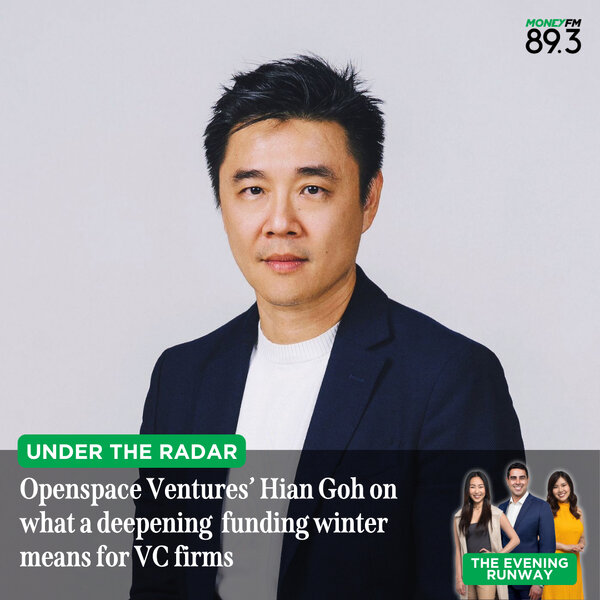
Using active intelligence to find and back companies creating transformational impact at the intersection of tech and life. That’s what we’re going to talk about today.
Founded in 2014, our guest is Openspace Ventures, a multi-stage investor that looks at Southeast Asian B2C and B2B businesses with a compelling vision for expansion.
The firm looks at three types of targets: (a) Series A and B firms with an established product-market fit and need capital for rapid scaling, (b) Series C and D firms who are market leaders with proven revenue traction but need capital for expansion into new markets or adjacent spaces and finally, (c) firms that belong to the rising asset class of crypto and Web3.
Openspace Ventures currently has 6 funds and over US$800 million under management, supported by regional institutional investors including Singapore’s state investor Temasek, Germany’s DEG, Norway’s Norfund and the Softbank Group.
The VC firm has over 45 portfolio companies under its belt and is one of the early investors into GoTo. Other notable companies it has invested in include Finnomena, Halodoc as well as homegrown fashion label Love Bonito.
But what role has Openspace Ventures played in helping its portfolio companies become who they are today using active intelligence and how far can that playbook be used for other startup targets?
Meanwhile, the SE Asia Deal Review compiled by DealStreet Asia revealed in May this year that startups in Southeast Asia raised US$1 billion in equity funding in the first quarter of 2024, down 41 per cent on a yearly basis.
Does this mean that VCs are more selective with investment targets? And given Openspace Venture’s focus on Web 3 firms, how does it screen for quality investments amid the generative AI craze? And is this the time for the firm to cash out on some of its existing investments?
On Under the Radar, The Evening Runway’s finance presenter Chua Tian Tian posed these questions to Hian Goh, Founder and General Partner, Openspace Ventures.
|
|
|
|
36:10
|
JUN 10, 2024
10/06/24 - Under the Radar: What remains of White pepper crab maker No Signboard after selling its trademark, and what is the firm doing to turn its business around?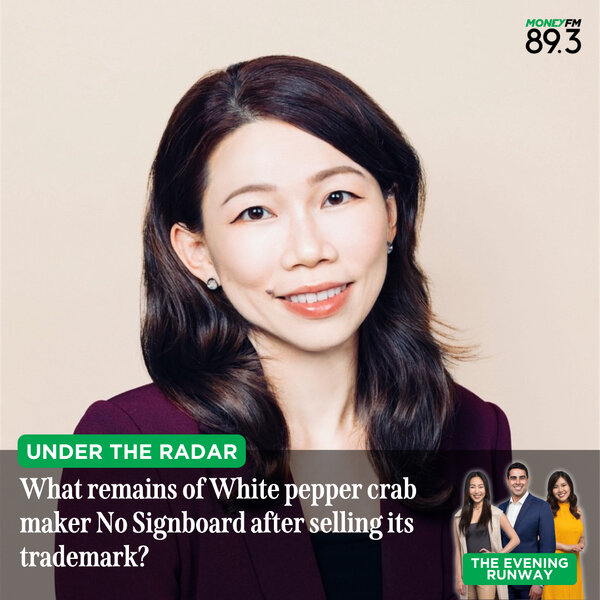
Most eateries and restaurants we eat at have a huge signboard at their entrances. But one seafood restaurant chain selling White Pepper Crab, however, doesn’t have
one.
You can perhaps already guess who my guest for today is. Started in the 1970s as a humble seafood hawker stall at Mattar Road Hawker Centre selling homemade White Pepper Crab, our guest No Signboard Holdings now prides itself as a lifestyle F&B player in Singapore.
The firm operates concepts such as No Signboard Seafood, Little Sheep Hot Pot and nosignboard Sheng Jian, and was listed on the Catalist Board of the Singapore Exchange in November 2017. It also has a beer business distributing beer brand Draft Denmark here in the lion city.
Why are we talking to No Signboard Holdings? Well, the company’s shares have been suspended since January 2022 after it was unable to prove that it can continue operations after the COVID-19 pandemic. Its beer business, Danish Breweries, was also put under voluntary creditors’ liquidation in March that year.
To keep the No Signboard Holdings afloat, the firm signed a rescue deal with Gazelle Ventures in May 2022, where Gazelle Ventures would invest S$5 million in No Signboard. But that wasn’t the end of the story, with the firm seeing a series of legal issues relating to its leadership since that deal.
After two tumultuous years for the seafood restaurant chain, the embattled F&B player got the nod from the Singapore Exchange Regulation to resume the trading of its shares on the 15th of March. But how does the firm intend to turn its business around?
Meanwhile, No Signboard also said in March that it will sell its trademarks under a settlement agreement to its former executive chairman, Lim Yong Sim, former controlling shareholder GuGong and Mattar Road No Signboard Seafood Restaurant.
But what will be left of No Signboard without its so-called ‘no signboard’ brand? And what value does No Signboard present for Gazelle Ventures, without its brand? Is this a case of backdoor listing for Gazelle Ventures?
On Under the Radar, The Evening Runway’s finance presenter Chua Tian Tian posed these questions to Lok Pei San, Chief Financial Officer, No Signboard Holdings.
|
|
|
|
27:54
|
JUN 6, 2024
06/06/24 - Under the Radar: How far is ComfortDelGro anchored in Singapore and the taxi business? Its Chairman Mark Greaves sheds light on the matter.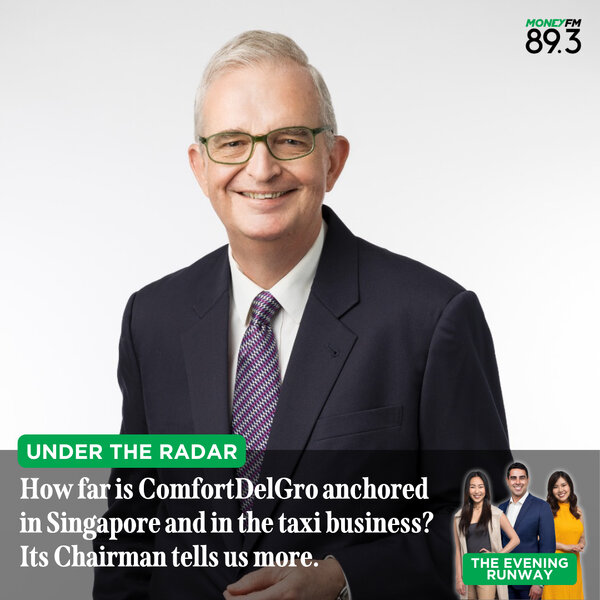
We’re going to talk about a company that is most famously known as a taxi and bus operator here in sunny Singapore.
Formed in March 2003 through the merger of two publicly-listed land transport companies – Comfort Group and DelGro Corporation, our guest is ComfortDelGro, and one of the largest land transport companies in the world.
The company's businesses now include bus, taxi, rail, car rental and leasing, automotive, inspection and testing services, driving centres, non-emergency patient transport services, insurance broking and even outdoor advertising.
Just to give you a sense of ComfortDelGro’s scale, the firm now operates in 12 countries such as Singapore, Australia, the UK, New Zealand and China, with a global fleet of about 40,000 vehicles.
In Singapore, the company owns 75% of the largest scheduled bus operator SBS Transit, and operates about 9,000 Comfort and CityCab taxis. And if you do drive, the firm is behind the car inspection company Vicom.
But why are we talking to ComfortDelGro you might ask? Well, ComfortDelGro had in May posted a 23.8 per cent year on year increase in net profit to S$40.6 million in Q1 ended March, thanks to higher revenue from its public transport, taxi and private hire vehicles, and lower rental discounts in Singapore and China.
But how does the firm assess its latest performance, and how far is this contributed by Singapore?
Meanwhile, the firm had in March told The Straits Times that the rail business is a key pillar for ComfortDelGro that it wants to double down on, with the firm working on tenders in the UK and Sydney. But why is this the case, and could the firm be moving away from its taxi business?
The firm had also in February this year acquired UK-based ground transport management and accommodation network specialist CMAC for £80.2 million (S$135.4 million). More recently, ComfortDelGro had in April announced an S$100 million green loan to decarbonise its bus fleet in the UK.
But what is the rationale behind the moves in its overseas markets? Are the UK and Australia stronghold markets for ComfortDelGro and what role does Singapore play in this regard?
On Under the Radar, The Evening Runway’s finance presenter Chua Tian Tian posed these questions to Mark Greaves, Chairman, ComfortDelGro.
|
|
|
|
37:57
|
JUN 4, 2024
04/06/24 - Under the Radar: From the offshore and shipyarding business to becoming a healthcare player – Catalist-listed AJJ’s transformation into the burgeoning medtech sector
It is all about advancing the healthcare landscape in the region as we speak to one of the leading providers of integrated medical technology solutions in Singapore and Southeast Asia.
Listed on the Catalist board of the Singapore Exchange, AJJ Medtech Holdings offers over 6,000 products ranging from healthcare consumables such as catheters to medical devices like blood glucose monitoring systems.
The company also offers more sophisticated equipment that can be used for the diagnostic imaging of cancer, as well as dental care-related devices. Some of its customers include public hospitals in Singapore, as well as players within the private healthcare landscape.
But what is interesting about AJJ Medtech Holdings was that the firm was formerly known as OEL Holdings up until February this year. And OEL Holdings wasn’t always in the healthcare space.
In fact, OEL Holdings, which was founded back in 1984 in Singapore, was in the offshore shipyard business until just five years ago in 2019. That was when a new management team was handed the reins of the company to break into the growing medtech sector.
The new management team had seen an opportunity in the rising demand for medical devices, and believed that taking over a publicly listed firm like OEL Holdings and pivoting it into a medical business was an efficient way to gain industry recognition and grow quickly.
But fast forward to today, how has the new management’s perceived "reverse takeover" of OEL Holdings’ helped it deepen its roots in the regional healthcare landscape and tap public capital?
Also, where are the bright spots for the firm looking ahead as the population in the region ages, and as countries like Singapore put in additional emphasis on community care?
On Under the Radar, The Evening Runway’s finance presenter Chua Tian Tian posed these questions to Yulei Zhang, Chief Strategy Officer, AJJ Medtech and Tan Wei Jie, Director of Business Development, AJJ Medtech.
|
|
|
|
37:57
|







